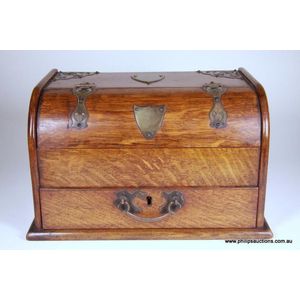Victorian Walnut & Brass Glove Box
You must be a subscriber, and be logged in to view price and dealer details.
Subscribe Now to view actual auction price for this item
When you subscribe, you have the option of setting the currency in which to display prices to $Au, $US, $NZ or Stg.
- Marbling - A descriptive term for a finish applied to plastic, ceramics, glass, plaster or wood to imitate the colours and characteristic markings of various marble types. For moulded items such as the first three above, the marbling is within the item.
Interiors and furniture were marbled from from the early 17th century to the late Victorian period. The craft was practiced by skilled decorators using a combination of brushes and sponges. Some of the finishes achieved were so realistic as to make it difficult to distinguish the marbled surface from the marble surface.
Marbling is also a term applied to a finish for paper as often seen in the front and endpapers of old books. The marbling is achieved by floating the colours on water and then transferring them to paper. However the marbling finish on paper, as with the marbling finish on plastics, with its multitude of colours has little resemblance to naturally occurring marble. - Circa - A Latin term meaning 'about', often used in the antique trade to give an approximate date for the piece, usually considered to be five years on either side of the circa year. Thus, circa 1900 means the piece was made about 1900, probably between 1895 and 1905. The expression is sometimes abbreviated to c.1900.
- Victorian Period - The Victorian period of furniture and decorative arts design covers the reign of Queen Victoria from 1837 to 1901. There was not one dominant style of furniture in the Victorian period. Designers used and modified many historical styles such as Gothic, Tudor, Elizabethan, English Rococo, Neoclassical and others, although use of some styles, such as English Rococo and Gothic tended to dominate the furniture manufacture of the period.
The Victorian period was preceded by the Regency and William IV periods, and followed by the Edwardian period, named for Edward VII (1841 ? 1910) who was King of the United Kingdom and the British Dominions and Emperor of India for the brief period from 1901 until his death in 1910.
This item has been included into following indexes:
Visually similar items

An oak Arts & Crafts writing box, later 19th century, the box with a curved front with a full length drawer which, when opened, mechanically activates the rolled lid to open revealing a partitioned section, the drawer also with partitions and a small metal

Early Victorian mahogany tea caddy, 35.5 cm wide, 18 cm high

A Chinese huanghuali document box, Qing Dynasty, 18th century, with bronze mounts, the bottom made from Jichimu. 11.5 cm high, 33 cm wide and 17 cm deep

19th century Georgian style mahogany tea caddy. Sarcophagus form, with lions head ring handles and mother of pearl escutcheon; with two internal compartments. Lids available but detached; mixing bowl replacement. Height 17 cm, length 31 cm
